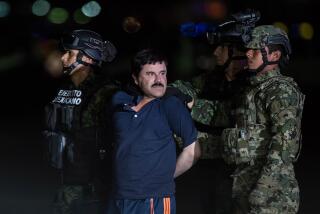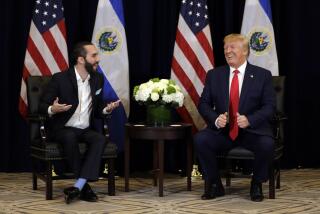Salvador Rebels Show Who’s Got the Grit
The attack by rebel forces on El Salvador’s second-largest military base on Tuesday says much about the situation in that republic. It also sheds light on attitudes and policies in Washington, where wishful thinking and short-term political considerations have completely replaced serious analysis with regard to Central America.
There are lessons to be learned from the events at El Paraiso base in Chalatenango, but they probably won’t be heeded.
The first and most obvious is that the Farabundo Marti National Liberation Front is alive and well. By infiltrating the base and pressing the attack for several hours, killing close to 100 soldiers and taking a large number prisoner, the FMLN showed what many observers--including Western European diplomats and intelligence officers--have known for some time: The insurgency has not been seriously weakened despite $1 billion in U.S. aid to the Salvadoran government. It is still capable of concentrating troop strength and firepower, and doing so quietly and efficiently. Its forces move back and forth across the country comfortably, attack and withdraw easily, and keep their losses low. And, as demonstrated at El Paraiso, the FMLN can draw on the entire spectrum of forces available--from elite commandos to semi-trained militias--in key engagements.
During the past year, Washington has insisted that its policy in El Salvador is succeeding, because both the size of the guerrilla forces and their territory have diminished. This analysis is superficial.
The Salvadoran air force’s bombing of guerrilla-held regions, together with other depopulation measures, did in fact reduce the size of the traditional zones of guerrilla influence. But the insurgents have extended their presence to areas where they had never operated previously. The best and most important example is the western region around Santa Ana, the country’s second-largest city. The FMLN has moved several hundred, and possibly more than 1,000, troops to this zone.
The rebels themselves have acknowledged that they have sent significant numbers of cadres into the capital, particularly since last fall’s earthquake that devastated San Salvador. The resurgence of urban mass protests and the awakening of the labor movement through the creation and growth of the National Union of Salvadoran Workers are both the cause and an effect of this “return to the cities.” These new urban phenomena are not led or manipulated by the FMLN, but its cadres are deeply involved in the movement.
With regard to the number of guerrillas under arms, whatever reduction may have occurred must be viewed with two caveats. The insurgents undeniably have experienced greater difficulty in obtaining ammunition both from abroad and from their main source, the Salvadoran army itself. This has obliged them in some instances to “furlough” combatants and bury weapons until matters improve. But this is a deliberate policy; in no way does it reflect discontent or disaffection within rebel ranks. No independent observer has reported any evidence of mass desertion from the revolutionary army during the past year or two, though scattered incidents unquestionably have occurred.
Another conclusion to be drawn from Tuesday’s pre-dawn attack on El Paraiso is that the much-vaunted improvement in the army’s performance is more public-relations propaganda than fact. The troops and officers were caught entirely by surprise; the perimeter of the base, heavily fortified after a similar attack in 1983, was easily penetrated. More seriously,the fact that only eight FMLN attackers were killed indicates that the troops hardly fought back, or did so very poorly. Although 200 enlisted men were killed or wounded, there were few officers among the casualties; on Thursday it was reported that they had hidden in a bunker. Finally, during the several hours of fighting, the 1st Military Detachment--almost 1,000 men based a few miles away--did not budge.
All this will only add to a deeper, long-standing problem affecting the army’s officer corps. They have been consistently demoralized by FMLN’s skillful tactic of exchanging individual captured officers for dozensof political prisoners or wounded guerrilla fighters--who, health permitting, immediately re-enter the FMLN ranks. This underscores the main obstacle that the Salvadoran armed forces have yet to solve: An army can be indefinitely expanded at troop level, but without an officer corps it cannot win a war.
What happened to President Jose Napoleon Duarte’s army and his American sponsors at El Paraiso is nothing but bad news. Not that they’ll admit it; to do so would be to admit that U.S. policy is at an impasse.
El Salvador is like Nicaragua, but in a way that is different from what many in Washington think. Both are examples of the Reagan Administration’s failed Central American policy, not of its successes. In less than two years Ronald Reagan will leave office, but Daniel Ortega will still be in Managua, and the FMLN will probably be closer to San Salvador than they were in January, 1981, when the President and Gen. Alexander M. Haig Jr. decided that the tiny Central American nation was the place to “draw the line.” Coming to terms, and to an understanding, with the Sandinistas and the Salvadoran insurgency may not be easier for the United States later than it is now. But, then, statesmanship and policy with an eye toward the long-term future were never this Administration’s strong suit.
DR, DOUMONT, Tiempo, San Pedro Sula, Honduras
More to Read
Sign up for Essential California
The most important California stories and recommendations in your inbox every morning.
You may occasionally receive promotional content from the Los Angeles Times.










